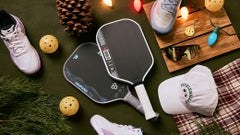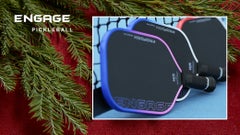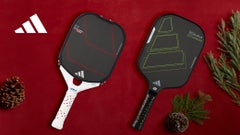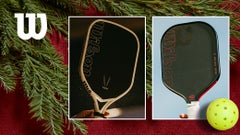From Tennis to Pickleball
If you'e a tennis player who's looking to try pickleball, we're here to help make the transition easier. We'll review the shared skills between the two sports, along with the shots, swing styles, footwork and rules that are specific to pickleball.
Capitalizing on Your Tennis Skills
Because tennis players know their way around the court, their skills in some ways give them a leg up in terms of gaining mastery of pickleball. Let’s look at the shots that cross over between the two sports.
- Groundstrokes: More or less the same in terms of the swing path for topspin and slice.
- Return of serve: More or less the same in terms of the swing path for topspin and slice.
- Serve: A pickleball serve is essentially a groundstroke from the hand or off the bounce. It’s a lot like an instructional ball feed in tennis.
- Chip or slice volley: The motion is the same but is more often used as a drop shot for pickleball.
- Lob: Although it’s the same motion as in tennis, the lob is used less often in pickleball if it’s windy.
- Overhead: It’s same motion as tennis, but it is harder to put away an overhead with a pickleball because it flies slower through the air.
Shots Unique to Pickleball
Although tennis players are familiar with most of the strokes used on the pickleball court, there are some unique shots to learn.
- Topspin volley: Rolling or applying topspin to volleys has become the standard in pickleball, especially at the intermediate and higher levels. Overall this is a more offensive tactic. In tennis the topspin volley (referred to as a swinging volley) is used far less where it has become a staple in pickleball. And although any level of player can hit the shot it is a definite sign that an expert pickler is in the mix if they are able to execute the topspin volley consistently and from a variety of areas of the court.
- Dink: A dink may be one of the easiest shots to hit, but some tennis players find that impatience creeps in after only a few dinks. Experienced pickleball players have the patience and diligence to maintain composure until an attackable shot is produced. Attackable shots are those that are near to or higher than the top of the net at the point of contact. Too often tennis players become impatient after a couple of dink exchanges and end up attacking shots that are not attackable. Getting comfortable with hitting multiple dinks seems to be one of the biggest adjustments that tennis players have to make. We go more in-depth in our article on How to Improve Your Dink Shots.
How Swing Style Differs
The consensus is that the length of your swing should often relate to your proximity to the net. The closer you are to the kitchen, the shorter the swing, and the farther away from the kitchen, the longer the swing path can be. Although the thought process is similar both sports, tennis players are used to creating a longer swing due to the larger court, longer racquet and faster, heavier ball. In pickleball, using a shorter backswing and follow through can still produce lots of pace. Additionally the shorter swing gives you more time to prep for and react to the next shot.
Differences in Footwork and Positioning
Traditionally, tennis players are taught to hit shots from a closed stance, and modern instruction advocates hitting from both an open and closed position.
In pickleball, especially near the NVZ, or non-volley zone also known as the kitchen, it’s ideal to maintain an open stance whenever possible. The main reason is that the hands are quicker than the feet in most circumstances. When hitting in closed stance near the kitchen, it requires either stepping back from the NVZ line giving away real estate or stepping forward into the kitchen, which gives away the point. As a result shuffling your feet and/or split stepping without having to cross one foot over the other is ideal in pickleball.
Pickleball Rule that Dictates Strategies
The rules of pickleball state that either player or team are allowed to hit an airborne shot until the second shot bounces (the two-bounce rule). Meaning that the serve landing in the returner's court is bounce #1 and the return bouncing on the server's side of the court is bounce #2. From there all players are permitted to hit shots out of the air of off the bounce, with the exception of the kitchen, where you have to let the ball bounce first.
The two-bounce rule makes it easy to spot tennis players who are new to pickleball, and most of the challenge relates to the server or serving team. For tennis players, especially in doubles, the instinct to serve and volley is hard to resist since the partner to the server in tennis can be positioned near the net to poach the return out of the air.
Unlike tennis, in doubles pickleball, it’s typical for for the serving team to play two back rather than one on the baseline and the other up at net.
In Conclusion
Experience in tennis gives you many tools that make it easier to get into the rhythm of playing pickleball. Adding these pickleball-specific skills and tactics to your repertoire of shots will boost your enjoyment of the sport and your pickleball IQ. Here are some parting words of encouragement:
- Construct and end points via approaching the kitchen rather than grinding from the baseline. This applies for singles but even more so to doubles.
- Increase your rally tolerance, especially when it comes to long dink rallies (think patience and diligence).
- Wait for the attackable ball (don’t go on the offense too soon).
- Get comfortable with rolling or applying topspin to your volleys instead of always relying on pushing or slicing.
- Use an open stance near the NVZ and avoid moving laterally by crossing your feet except in rare circumstances.
-IMG-05.jpg&nw=780)









